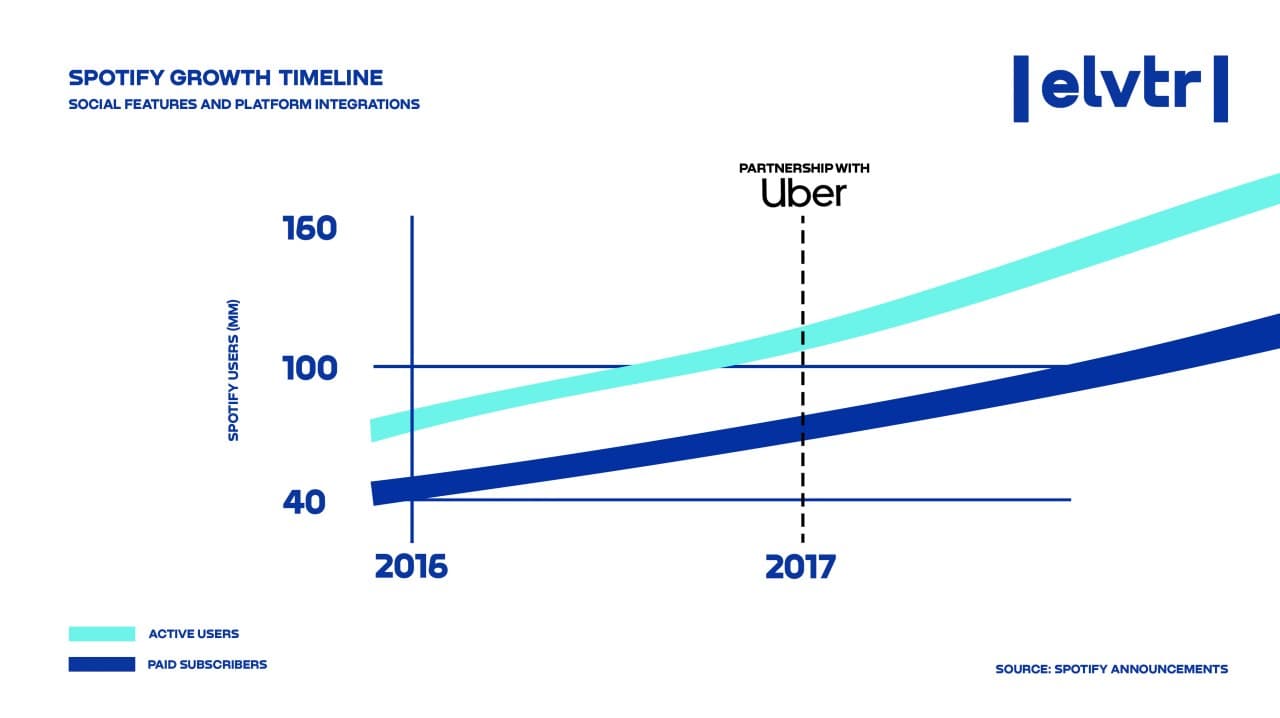- MAIN PAGE
- – elvtr magazine – DECODING STRATEGIC PARTNERSHIPS
DECODING STRATEGIC PARTNERSHIPS

When an Uber passenger scrolls through Spotify, she is choosing the soundtrack to her commute. The music of her choice will start playing as she swings the car door open and begins her journey. It’s a simple decision – why not play DJ? – but it’s one that will encourage, in a small but reliable way, that she will begin to engage in app usage during rides. And because this feature is only available to Spotify Premium subscribers, she associates this customization with luxury.
The harmonious pairing between Spotify and Uber is a specific kind of collaboration: a strategic partnership.
A strategic partnership is a symbiotic relationship between two entities which, ideally, create a mutually advantageous environment. Like any strong relationship, a strong strategic partnership links two parties with a shared vision and a shared objective. The two parties lean into their individual strengths to create a formidable, reciprocal environment. Uber and Spotify benefit each other, and the Uber passenger can opt out of small talk with a customizable feature.
Relationships show us new ways of navigating our lives. The right partnership can show you a new way of reaching your audience, encourage innovation and increase revenue. A strategic partnership maintains independence for each brand involved while bolstering a shared vision.
Like any relationship, a healthy strategic partnership can compound success. Uber is not the only strategic partnership Spotify has made. Among other heavy-hitting brands are Samsung and Adidas. Each partnership made sense – but a strategic partnership goes beyond making sense. Spotify’s tactical approach to business relationships has pushed their premium services, as well as their global reach.
Sure, the reason for their success does not rest solely on this strategic partnership. However, a calculated approach to business relationships can bolster your vision and open doors you wouldn’t have had access to otherwise. How businesses achieve and maintain that a strategic partnership is up to them, but there are a few different categories that provide the framework for navigating them.
Types of Strategic Partnerships
The term “strategic partnership” could seem like the new “synergy,” but don’t dismiss the concept just yet. Look closer. However buzzworthy the term has been, the concept certainly isn’t new. In fact, strategic partnerships are more ubiquitous than you would guess.
- Strategic marketing partnerships: This alliance is a simple way to double exposure. Linking complementary products means both can possibly reach twice as many people! Even if there is some overlap among your target audiences, the returns can be astounding. Taco Bell and Doritos teamed up in 2012 to createthe Doritos Locos Tacos. The flavorful collaboration sold 100 million tacos in the first ten weeks on the market and is still available today.
- Strategic supply chain partnerships: Make a necessity a helpful tool by building a network of go-to suppliers. A strategic supply chain partnership streamlines the flow of products and services in a reliable, reciprocal manner from idea generation to tracking results. The music industry relies on supply chain partnerships. Think of it this way: A certain artist may work under one record company. This artist collaborates with other artists on the same label, or artists she shares affiliations with through management. Everyone plays their part and keeps the flow steady.
- Strategic integration partnerships: Remember the Uber ride, complete with Spotify? The strategic integration of Spotify and Uber generated an immersive and unique experience that only came about by each company leaning into the other’s expertise. The passenger had to pay the $10/month subscription fee for Spotify Premium to access this feature, and this feature was only available through Uber. Uber has since recruited Spotify’s competitor, Pandora, for a similar treatment.
- Strategic technology partnerships: This is a more straightforward approach that doesn’t result in a new product or campaign. Basically, utilizing IT expertise found outside of your resources would be categorized as a strategic technology partnership. Breaking down daily operations can be broken down into seamless tasks by, for example, partnering with a storage platform.
- Strategic financial partnerships: Taking the same approach as strategic accounting and technology partnerships, strategic financial partnerships utilize outside talent. A specialist’s insight can cut costs through monitoring finances with an objective eye. An alliance with a specific accounting firm is a common example of a strategic financial partnership.
Psychological Aspects
Setting the tone: Strategic engagement with prospective partners begins with identifying the goal of the possible partner’s culture. An ideal candidate will have a similar culture that is aligned with a common goal. Spotify and Uber, again, exemplified a seamless collaboration in this regard.
Spotify and Uber are both hypermodern and accessible services. The strategic integration Their shared customer’s experience was heightened by their joint endeavor. Was it necessarily a problem that passengers did not have the option to play their music before? Well, no. However, the common goal for Spotify and Uber was not to join forces to fix a problem but to create something fun and useful. The fun and useful option of being your own DJ was only available to those with Spotify premium accounts.
Your goal can be to fill a niche that’s already needed -- or create one tailored to the needs of your partner and yourself.
- Be genuine. Are you an intense, ambitious person, or are you more of a creative type? Lean into who you are – and who they are. A strategic partnership is strengthened by trust. If you prefer communicating via text over a video call, reach out that way. If you need help formulating an idea, say so. No matter who you are, or who they are, a genuine approach to connections establishes trust.
- Be reliable. Allowing small acts to demonstrate your reliability speaks volumes. Even if you haven’t established a strategic partnership, your accountability to yourself will serve as a model for how you would conduct business. You follow up on emails, remember names, and maintain satisfied connections. These small acts, bit by bit, build your reputation.
- Be adaptable. Adaptability is how the strong survive, after all. Adjusting to your environment and to a potential partner’s preferences is imperative. For example, a pitch that reads as overreaching to some — would be ambitious to others. A solid idea could fall flat with someone who isn’t quite the right fit. Being flexible and creative in your approach is another way to show your style.
Legal Strategic Partnerships
Legal strategic partnerships rely on binding agreements that provide a clear-cut understanding of expectations. They can be placed into three categories: joint ventures, equity alliances, and non-equity alliances.
- Joint venture: When two or more businesses establish a new company, the new company is a joint venture. The joint venture acts as its own legal entity with profits divided according to contract terms. A joint venture can be split equally into a 50/50 agreement, but it can also be split into what is called a majority- owned venture – and companies can take on more or less than 50 percent. The parent companies are entitled to their agreed upon share. A joint venture which may be temporary or indefinite. Like Uber and Spotify, Starbucks and Barnes & Noble created a joint venture when they added cafés to their brick-and-mortar bookstores. When you purchase a Starbucks coffee at a Barnes & Noble, the purchase goes toward both the bookstore and the coffee shop.
- Equity alliance: An equity alliance is a strategic partnership that entails an initial investment made by one or more of the parties. The investment acts as an exchange for the equity of another company. An equity alliance can work in tandem with other endeavors both companies engage in together.
- Non-equity alliance: A non-equity alliance is less centered on controlling portions of revenue so much as specifying allocation of assets between all of the involved parties. Unlike an equity alliance, there is no new entity, and each company maintains its independence.
Conclusion:
Our Uber passenger has arrived at her destination. The music has stopped – for now. When she goes for a run tomorrow morning, she will listen to a Spotify playlist powered by Adidas.
Taking a tactical approach to business relationships is a thoughtful and logical process, and further understanding strategic partnerships is a powerful method to make thoughtful and logical processes part of our daily lives. Demystifying the concepts of strategic partnerships shows us that they’re everywhere. Legacy brands and new companies alike are working in changing professional environments and adapting to fit our evolving needs. Forming strategic partnerships helps to make these transitions seamless.
It’s simple enough. The relationships we forge form networks in our personal lives as well as professional lives. A successful network is one that has clear standards and yields efficient, measurable results. Opening one door leads to a new space, and that space should be a cooperative environment where you and your partners can thrive.
*ELVTR is disrupting education by putting proven industry leaders in a virtual classroom with eager rising stars. ELVTR courses offer 100% instructor driven content designed to give you practical knowledge within a convenient time frame. Choose the right course for you!


